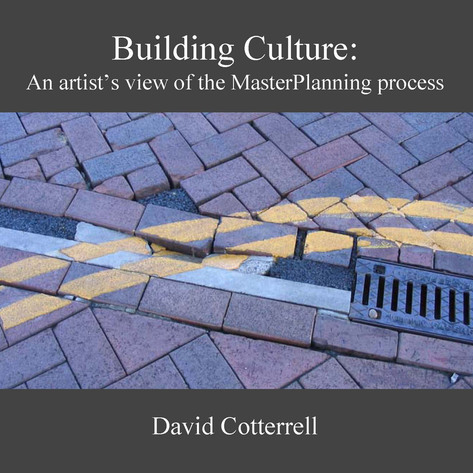Building Culture
Event Name: Creative Clusters ConferenceVenue/Location: Europa Hotel, Belfast
Date: 26th October 2005
NESTA, Belfast City Council, Arts Council of Northern Ireland
Chair/Other Speakers:
Brendan McMenamin (Derry City Council - Chair); Andrew McIlroy; Sheila Graham
Paper delivered to international conference on creative economies.
Programme:
The Role of Artists: Animateur, peacemaker or "stormtrooper of the bourgoisie"? Chaired by Brendan McMenamin, Derry City Council
The creative industries have transformed the role of 'artist as creator' beyond recognition. The artist - the creative individual, is now asked to practice mutiple roles in multiple contexts, and as lessons learned in one field are applied in another a 'culture of creativity' emerges. This session explores the practical engagement of art, artists and creativity in urban planning, housing development and conflict resolution, and asks 'what is the changing role of the artist?'
Building Culture (An Artist's View): The emergence of strategic integration of culture within master-planning. David Cotterrell, Senior Lecturer in Fine Art, Sheffield Hallam University, UK
"ArtWorks" A New Investment Model: Investing to anchor creative people and institutions in urban developments. Andrew McIlroy, International Projects Manager, Futurecity, Belgium
The Case of Mountain View, Jamaica: The role of creativity in conflict resolution and community development. Sheila Graham, Director, Area Youth Foundation, Jamaica
Abstract:
A personal view of the successes and weaknesses of attempts to set precedents for integration of cultural ambition within blueprints for economic and infrastructure growth. Cotterrell's experience of attempting to engage with the argument that cultural wealth can be seen as a prerequisite for economic success. The emergence of consensus and vision within a regional centre.
In early 2004, David Cotterrell was appointed to the post of Artist-in-Residence to the Master-planning process, for the Greater Ashford Area or the South East of England. This post was initiated by the Arts Council England, not to enable Cotterrell to develop artwork, but to embed an artist within the design teams and political processes seeking to define a growth plan for the region. The outcome of Cotterrell's 18 month period as an internal lobbyist and advocate for culture within planning and development is the subject of this presentation.
Ashford has been defined as one of the ODPM's four key growth areas in the South of England. Ashford is the home to the first international rail terminal for arrivals in the UK through the EuroTunnel link. The completion of the high speed rail connection to London in 2007, will support its integration within a European transport system. Reflecting this opportunity, Ashford has embarked on a period of significant growth. A team of national consultants, agencies and government bodies have been assembled to deliver a masterplan for 35 years of development. Ashford has committed to delivering 29,000 new jobs and 31,000 homes over this period. The identity and priorities of this new urban centre, with a population similar to Cambridge, has been the subject of intensive study, consultation and debate. It represents an unusual opportunity to provide real engagement with the ideas of 'Sustainable Communities' and 'Integrated Transport Systems'. Ashford has suffered from strident planning decisions which have damaged the character and viability of this historic market town. A dominating ring-road, and surface car parking have fragmented the public realm and undermined the economic viability of the town centre. Ashford's connection with its wider residential communities has been strained. Its cultural facilities, cinemas, theatre, art galleries and museums, have been destroyed to accommodate road junctions, poor-quality commercial development and out of town facilities. The significant investment guaranteed by the master-planned period allows for a reevaluation of priorities and an attempt to integrate cultural, social and community development within the inevitable retail, leisure and housing growth.
Cotterrell, was tasked with supporting opportunistic short-term interventions, public consultation and with trying to influence policy and planning. In the absence of identifiable cultural representation within the master-planning teams, Cotterrell was afforded access to all levels and areas of local government and agency activity.
While developing an understanding of the mechanisms of local government and development agencies, Cotterrell began to assist the commissioning of international artists within commercial and public initiatives. These initial precedents provided evidence and momentum for a sustained debate focusing on the positioning of culture as a key objective within the masterplan. Benevolent, but fragmented initiatives by independent agencies and departments were supported and documented. Recognition of the need for enhanced awareness and interdisciplinary collaboration began to emerge. The completion and adoption of a cultural chapter within the masterplan, the emerging enthusiasm for a strategic development tariff and growing evidence of the importance of culture in facilitating economic growth, allowed for discussions to be initiated on the potential for the development of new models of cultural coordination and facilitation.
As the residency draws to a close, Cotterrell is supporting the definition of a new and emboldened approach to curation and funding within a strategic growth project. The key facets of this initiative will involve the establishment of an inter-agency, independent curatorial body for Art and Architecture and An Endowment for the Arts. Cotterrell's reflections on Ashford's involvement, within a national cultural debate are the subject for this case study.
Share:
Twitter / Facebook / Pinterest

